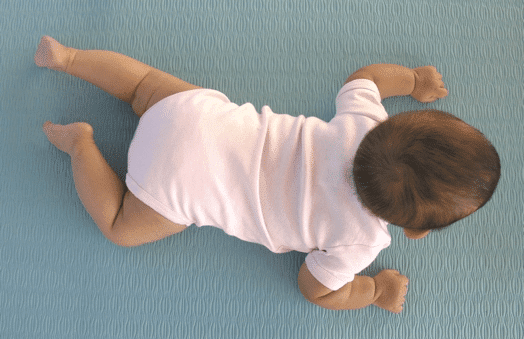Immobile to Crawling
Results: The only thing that matters in the world of hurt kids
At birth a newborn baby is immobile: the baby can move his arms and legs freely but cannot move forward. This is the first stage and at this point the baby is essentially immobile.

A newborn baby needs a user-friendly floor environment that makes it easy to move.
As the baby has more opportunity on his belly on the floor the baby moves his arms and legs more. The more he does so, the better he gets. He is makes many experiments to discover what he needs to do in order to move forward. At first, he may actually move backwards or pivot around. Although this may appear to be frustrating for him, this is progress.
When a baby begins to actually move forward this is the beginning of crawling and it is a very important stage in the baby’s development.
Injury to the brain either before, during or after delivery can result in immobility or paralysis. This is because of injury to the motor pathway not injury to the arms and legs.

A baby crawling track is a user friendly floor environment. After opportunity in the track, the newborn baby is crawling in a matter of days.
Appropriate sensory stimulation and motor opportunity are the answer when the motor pathway is in trouble. When the child is provided with appropriate sensory stimulation with increased frequency, intensity and duration in recognition of the orderly way in which the brain develops and then given ample opportunity to move, that pathway will grow. The child will begin to move a few inches, and then a few feet, and then use crawling as the means of transportation from place to place. Once a child can crawl across a room he is no longer immobile.
Diego

Diego no longer crawls for transport, now he is walking independently.
Diego was diagnosed with the genetic disorder, Trisomy 8. He was 11 months when he started the program. He had restricted movement of his arms and legs due to rigidity. After being given daily stimulation and opportunity to move he learned how to crawl for his own needs after fourteen months. He crawled at least 160 meters in a day. Today Diego not only creeps more than a thousand meters daily on his hands and knees, he is walking independently.
Beatriz

After appropriate stimulation and opportunity Beatriz could easily crawl eight meters in four minutes.
Beatriz began the program when she was 22 months old. She could move her arms and legs, and she could rolled over when placed on the floor but she could not move forward or backward. She was given daily opportunity to move down an inclined floor and 11 months later she was crawling 200 meters daily. She has now doubled that distance.
Yukia

Yukia using her overhead ladder
When Yukia began the program she was 40 months old. She could move her arms and legs but could not move forward on the floor. A year and a half later, after daily opportunity on the floor, she learned how to crawl 50 meters in a day. She could crawl 20 meters non-stop. Now she can crawl 100 meters daily.
Each of these children were immobile. Sometimes parents are told when they have an immobile child that this cannot be changed and it may be permanent. Now each of these children can move and explore the world around them and enjoy that world. The quality of their lives has changed immeasurably for the better. These results were brought about by the efforts of each family. Mother and Father, brothers and sisters and the child – all working together to give each child a fighting chance for a much better life.
Click here to Read More about Results with 3,024 Children on The Institutes Program
Learn More About the What To Do About Your Brain-Injured Child course
For more information, or to enroll, Contact Ashley
Phone: 215-836-4868
Email: wtd_registrar@iahp.org

 Donate
Donate








